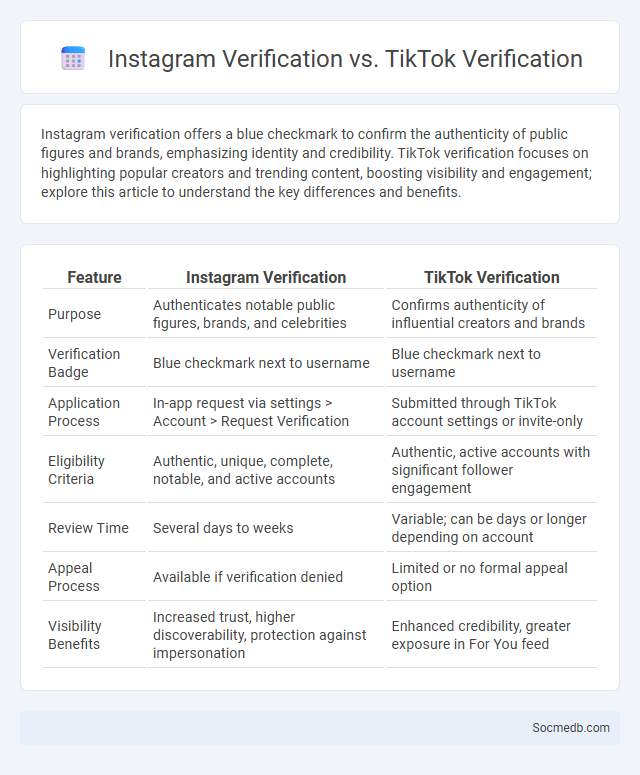
Photo illustration: Instagram Verification vs TikTok Verification
Instagram verification offers a blue checkmark to confirm the authenticity of public figures and brands, emphasizing identity and credibility. TikTok verification focuses on highlighting popular creators and trending content, boosting visibility and engagement; explore this article to understand the key differences and benefits.
Table of Comparison
| Feature | Instagram Verification | TikTok Verification |
|---|---|---|
| Purpose | Authenticates notable public figures, brands, and celebrities | Confirms authenticity of influential creators and brands |
| Verification Badge | Blue checkmark next to username | Blue checkmark next to username |
| Application Process | In-app request via settings > Account > Request Verification | Submitted through TikTok account settings or invite-only |
| Eligibility Criteria | Authentic, unique, complete, notable, and active accounts | Authentic, active accounts with significant follower engagement |
| Review Time | Several days to weeks | Variable; can be days or longer depending on account |
| Appeal Process | Available if verification denied | Limited or no formal appeal option |
| Visibility Benefits | Increased trust, higher discoverability, protection against impersonation | Enhanced credibility, greater exposure in For You feed |
Understanding Social Media Verification
Social media verification confirms the authenticity of accounts, typically through a blue checkmark badge on platforms like Twitter, Instagram, and Facebook. This process helps users identify credible public figures, brands, and influencers, reducing the risk of impersonation and misinformation. Verification criteria often include account completeness, notability, and adherence to community guidelines, making it a crucial tool for trust and transparency online.
What is Instagram Verification?
Instagram Verification is a process that grants a blue checkmark badge to authentic public figures, celebrities, brands, or entities, confirming their identity and distinguishing official accounts from impersonators. This verification enhances credibility, increases visibility in search results, and often provides access to additional features such as swipe-up links in Stories. Securing Instagram Verification requires meeting criteria like account completeness, authenticity, uniqueness, and adherence to Instagram's community guidelines.
What is TikTok Verification?
TikTok Verification is a process that confirms the authenticity of a user's account by granting a blue checkmark badge, indicating it is the official presence of a public figure, brand, or creator. Your verified status enhances credibility, increases visibility, and helps prevent impersonation on the platform. Verification is typically offered to accounts with a significant following, high engagement, and adherence to TikTok's community guidelines.
Overview of General Verification Processes
Social media platforms employ general verification processes that typically involve identity confirmation through official documents or unique identifiers to ensure account authenticity. The verification helps You establish credibility and distinguish your account from impersonators by displaying a verified badge. These processes vary by platform but often include form submission, manual review, and compliance with specific eligibility criteria such as follower count or public interest.
Eligibility Criteria: Instagram vs TikTok
Instagram requires users to be at least 13 years old and comply with its community guidelines for account creation, emphasizing real identity verification and a minimum follower count for business or creator accounts. TikTok also sets a minimum age of 13 for users, with stricter content policies for users under 18 and additional verification steps for accounts seeking verification or promotional features. Both platforms enforce regional restrictions based on local laws, influencing eligibility and access to advanced tools like advertising and analytics.
Application Process: Step-by-Step Comparison
The application process for social media platforms like Facebook, Instagram, and LinkedIn involves creating an account by providing personal information, verifying identity through email or phone, and setting up security measures such as two-factor authentication. Facebook requires users to choose a personal profile or business page, while Instagram focuses on profile creation with options for public or private accounts. LinkedIn emphasizes professional details, prompting users to input work experience, education, and skills to optimize networking and job opportunities.
Benefits of Being Verified on Each Platform
Being verified on social media platforms like Twitter, Instagram, Facebook, and LinkedIn enhances credibility, increases visibility, and protects against impersonation. Verified badges improve user trust, often leading to higher engagement rates and expanded networking opportunities. Each platform's verification boosts algorithmic favor, promoting content reach and establishing a professional digital presence.
Key Differences Between Instagram and TikTok Verification
Instagram verification requires a blue checkmark badge to confirm public figure, celebrity, or brand authenticity, emphasizing established presence and account completeness. TikTok verification prioritizes content creator influence, engagement metrics, and adherence to community guidelines, focusing on dynamic popularity over a static following. Both platforms demand authenticity but diverge in measurement criteria, reflecting Instagram's emphasis on identity verification and TikTok's focus on trending content impact.
Common Challenges and Myths about Verification
Social media verification often faces challenges such as identity theft, fake accounts, and inconsistent platform requirements that hinder authentic user recognition. Many believe verification guarantees credibility, but it primarily confirms identity, not content accuracy or influence. Understanding these myths helps you navigate verification's limitations and leverage its benefits effectively.
Choosing the Right Platform for Verification
Selecting the appropriate social media platform for verification is crucial to reach the targeted audience effectively, with Instagram and Twitter leading due to their high user engagement and real-time content sharing. Platforms like LinkedIn offer enhanced credibility for professional verification, leveraging detailed user profiles and industry connections. Understanding each platform's demographics, user behavior, and verification criteria ensures maximizing authenticity and visibility in verified status.
 socmedb.com
socmedb.com